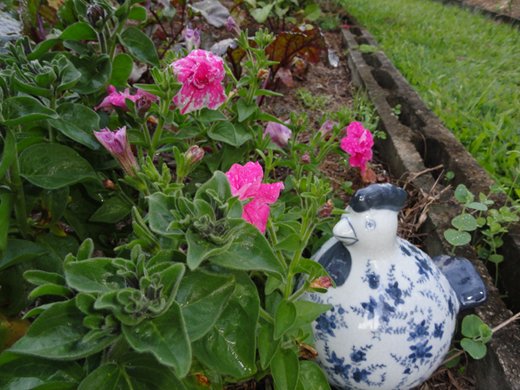If you are gardening organically, there is a lot more to it than planting seeds and fertilising. Organic gardening is a holistic method, a complexity of intertwined links between the gardener, the plants, soil, humus, microbes, minerals, water, compost, mulch and visiting insects. One of the ladies asked for a post about beneficial flowers in the garden. They are a great example of that holistic complexity because planting flowers in with the vegetables will attract beneficial insects that will not only help with pollination but also kill parasitic bugs or the sap suckers like aphids.
Any flower that attracts bees is a good addition in the vegetable patch but there are certain flowers that attract the right sort of insects:
- Cosmos
- Daisies, including echinacea, feverfew, chrysanthemums, gerberas and chamomile
- Red clover
- Queen Anne's Lace
- Carrot flowers
- Dill flowers
- Marigolds
- Alyssum
- Nasturtiums
- Yarrow
- Borage
When I choose flowers for the vegetable garden, I choose those that will attract bees, predatory wasps, beetles, lady beetles, spiders and centipedes, and I also choose those that help me in the home as well. For instance, planting calendulas will attract bees and predatory wasps, and I can use the petals to make calendula salve. Having a few lavender plants will give me lavender for my cleaning products whether it's flowering or not. I love growing yarrow because, like comfrey, it helps stimulate decomposition in the compost heap and looks delightful in an arrangement of flowers on the kitchen table. When the nasturtiums grow wild and threaten to take over the garden, use them as extra green waste for the compost heap - they are the easiest plants to pull out.
When you decide to follow this path with beneficial plants and flowers, it's a good idea to look in your local library to see if they have a book on your local varieties. While that should be your guide, the flowers I've listed above should serve you well if you can't find a local resource.
Another elements you can add to this mix is a bowl of fresh water for the visiting insects. Make sure you place some pebbles or an upturned pot in the water for the insects to land on and to drink from. If they fall into the water, often, they drown. So providing a safe landing and drinking spot for them will see them return day after day to work in your garden.
Don't forget the fragrant flowers as well. Fragrance will help attract bees - such as the orange blossoms above. Walking into a garden full of healthy vegetables, or with shoots showing the promise of what will come, is complemented by fragrance as you walk through it. Out in the garden there is no plastic, steel or aluminium; this is the natural world in all its glory. Enjoy it, get your hands dirty, and silently thank all those visiting helpers who visit your garden every day.
If you plant certain flowers in your garden, please tell us about them and tell us your location too so we know what works in certain areas.
ADDITIONAL READING
Frances has written an excellent guide to beneficial bugs and flowers at Green Harvest.
ADDITIONAL READING
Frances has written an excellent guide to beneficial bugs and flowers at Green Harvest.




